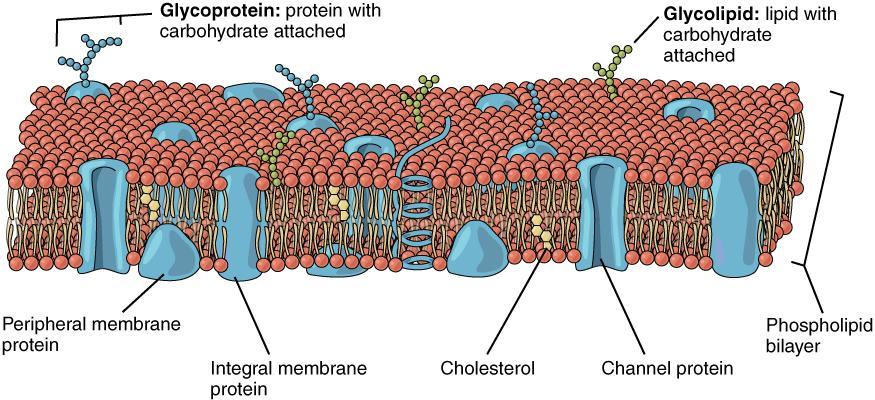
Explain ‘Fluid mosaic model’ of plasma membrane.
Answer
468k+ views
Hint: Plasma membrane is also called the cell membrane. It is the membrane found in all the cells. It separates the interior of the cell from the external environment of the cell.
Complete answer:
Fluid mosaic model of plasma membrane:
1.The fluid mosaic model of plasma membrane was proposed by the S.J. Singer and Garth L. Nicolson in 1972.
2.The fluid mosaic model of plasma membrane describes the structure of the plasma membrane.
3.The plasma membrane contain the components like phospholipids, cholesterol, proteins, and carbohydrates
4.These all components of the plasma membrane give the membrane a fluid character.
5.Plasma membrane ranges from 5 to 10 nm in thickness.
6.The proportions of the components of plasma membrane that are proteins, carbohydrates, lipids vary with the cell type.

Components of the plasma membrane:
There are the three components of the plasma membrane:
A.Phospholipids
B.Carbohydrates
C.Proteins
Phospholipids:
1. Phospholipids are the class of lipids that are present in the plasma membrane.
2. A phospholipid is a molecule which consists of glycerol, two fatty acids and one phosphate linked head group.
3. They are amphoteric in nature which means that they have a polar or hydrophilic head and a no-polar or hydrophobic tail.
4. Phospholipids arrange themselves in a manner that their hydrophobic tails facing each other and hydrophobic heads facing out.
5. There is a barrier created by this arrangement and gives a bilayer structure to the cell membrane.
Proteins:
1. The plasma membrane has integral proteins embedded in them.
2. It is the second major component of the plasma membrane.
3. These proteins are completely embedded into the membrane structure with their hydrophobic membrane regions interacting with the hydrophobic regions of the phospholipid bilayer.
Carbohydrates:
1. Carbohydrates are the third major component of the plasma membrane.
2. Carbohydrates are always found on the exterior surface of the cells where they are bound either to proteins (forming glycoproteins) or lipids (forming glycolipids).
Note: Plasma membrane is semi-permeable membrane which means that it allows the movement of selective molecules or ions across itself. Plasma membranes perform various functions like osmosis, endocytosis, exocytosis, diffusion, etc.
Complete answer:
Fluid mosaic model of plasma membrane:
1.The fluid mosaic model of plasma membrane was proposed by the S.J. Singer and Garth L. Nicolson in 1972.
2.The fluid mosaic model of plasma membrane describes the structure of the plasma membrane.
3.The plasma membrane contain the components like phospholipids, cholesterol, proteins, and carbohydrates
4.These all components of the plasma membrane give the membrane a fluid character.
5.Plasma membrane ranges from 5 to 10 nm in thickness.
6.The proportions of the components of plasma membrane that are proteins, carbohydrates, lipids vary with the cell type.

Components of the plasma membrane:
There are the three components of the plasma membrane:
A.Phospholipids
B.Carbohydrates
C.Proteins
Phospholipids:
1. Phospholipids are the class of lipids that are present in the plasma membrane.
2. A phospholipid is a molecule which consists of glycerol, two fatty acids and one phosphate linked head group.
3. They are amphoteric in nature which means that they have a polar or hydrophilic head and a no-polar or hydrophobic tail.
4. Phospholipids arrange themselves in a manner that their hydrophobic tails facing each other and hydrophobic heads facing out.
5. There is a barrier created by this arrangement and gives a bilayer structure to the cell membrane.
Proteins:
1. The plasma membrane has integral proteins embedded in them.
2. It is the second major component of the plasma membrane.
3. These proteins are completely embedded into the membrane structure with their hydrophobic membrane regions interacting with the hydrophobic regions of the phospholipid bilayer.
Carbohydrates:
1. Carbohydrates are the third major component of the plasma membrane.
2. Carbohydrates are always found on the exterior surface of the cells where they are bound either to proteins (forming glycoproteins) or lipids (forming glycolipids).
Note: Plasma membrane is semi-permeable membrane which means that it allows the movement of selective molecules or ions across itself. Plasma membranes perform various functions like osmosis, endocytosis, exocytosis, diffusion, etc.
Recently Updated Pages
The correct geometry and hybridization for XeF4 are class 11 chemistry CBSE

Water softening by Clarks process uses ACalcium bicarbonate class 11 chemistry CBSE

With reference to graphite and diamond which of the class 11 chemistry CBSE

A certain household has consumed 250 units of energy class 11 physics CBSE

The lightest metal known is A beryllium B lithium C class 11 chemistry CBSE

What is the formula mass of the iodine molecule class 11 chemistry CBSE

Trending doubts
State the laws of reflection of light

One Metric ton is equal to kg A 10000 B 1000 C 100 class 11 physics CBSE

Difference Between Prokaryotic Cells and Eukaryotic Cells

What is the modal class for the following table given class 11 maths CBSE

How do I convert ms to kmh Give an example class 11 physics CBSE

Give an example of a solid solution in which the solute class 11 chemistry CBSE




